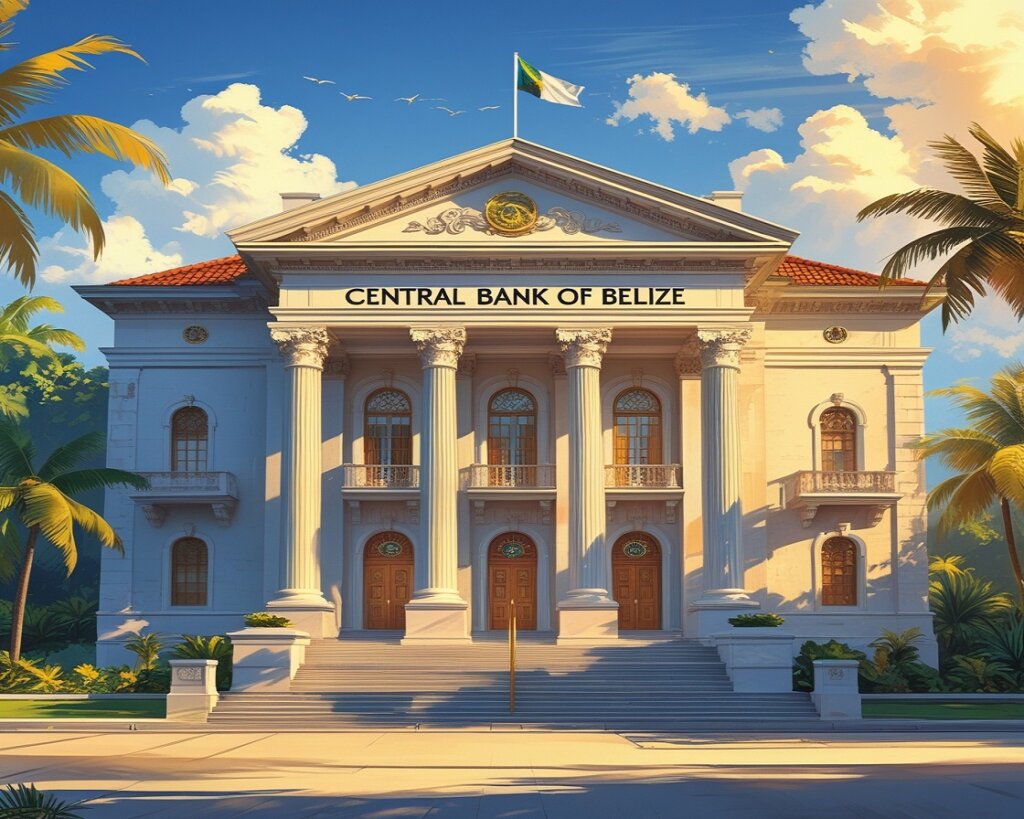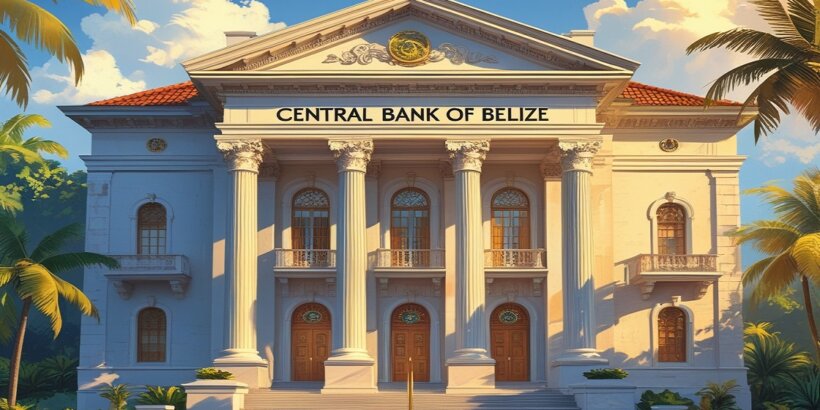Central Bank of Belize: Comprehensive Overview
Introduction
The Central Bank of Belize (CBB) stands as the foundation of Belize’s financial and monetary stability. Since its inception, the CBB has played a critical role in guiding the country’s economic development. This article provides an in-depth look at the Central Bank’s history, mission, vision, organizational structure, and core responsibilities.

History of the Central Bank of Belize
The Central Bank of Belize was established on January 1, 1982, succeeding the Belize Monetary Authority (BMA). This marked a significant step toward Belize’s financial independence, providing a structured approach to managing monetary policy and ensuring financial stability. The transition reflected the country’s economic progress and the necessity for an autonomous financial institution to address evolving global economic challenges.
Over the decades, the CBB has grown in its capacity, adapting to changing economic landscapes and consistently fulfilling its mandate of promoting monetary stability and economic growth.
About Us: The Central Bank of Belize
The Central Bank of Belize operates as a statutory entity tasked with ensuring the stability of Belize’s monetary system. Its establishment under the Central Bank of Belize Act, Chapter 262 of the Laws of Belize underscores its commitment to fostering economic development and financial resilience.
Mission, Vision, and Values
Mission The Central Bank of Belize is committed to promoting monetary and financial system stability to support Belize’s economic growth and development.
Vision To be a premier institution recognized for excellence, trust, and contribution to national progress.
Core Values
- Integrity: Upholding the highest ethical standards.
- Excellence: Striving for innovation and superior performance.
- Transparency: Operating with clarity and openness.
- Collaboration: Building partnerships to achieve shared goals.
- Sustainability: Encouraging long-term economic and environmental stability.
Headquarters of the Central Bank of Belize
The headquarters of the Central Bank is located at: Gabourel Lane, Belize City, Belize.
This modern facility supports the Bank’s operational efficiency and ensures secure management of its diverse functions.
List of Governors
Leadership at the Central Bank of Belize has been pivotal in shaping its direction. Here is a list of notable Governors:
- Sir Manuel Esquivel (1982–1984)
- Sydney Campbell (1985–1991)
- Keith Arnold (1991–2002)
- Glenford Ysaguirre (2008–2016)
- Joy Grant (2016–2021)
- Kareem Michael (2021–Present)
Core Functions:
- The payments system facilitates the discharge of financial obligations and the safe transfer of funds across distances and institutions. The Central Bank of Belize recognizes that a safe, reliable and efficient payment system is central to the stability of the financial system. A developed payment system links financial institutions and payments and securities settlements systems and is underpinned by robust legal and regulatory framework.
Payments System Reform
The National Payment System (NPS) reform project began in 2010, with the goal to modernize Belize’s payment system. On 21 October 2016, with collaboration of all participant banks and the Government of Belize, the Central Bank launched the automated transfer system and central securities depository, the backbone infrastructure of the NPS reform. This system, named the Automated Payment and Securities Settlement System or APSSS, provides electronic funds transfer, automated cheque processing services, and automated primary market operations.
2) Prudential Regulation and Supervision
The Supervision Department is responsible for the prudential regulation and supervision of domestic and international banks, credit unions, other financial institutions, moneylenders, and payment service providers and operators in Belize. In this respect, we develop policies and regulations for the financial sector to ensure that financial services and products are provided in a safe and sound manner. These institutions are also supervised to maintain a robust and comprehensive view of the sector’s activities to ensure compliance with policies and regulations, identify risks as they arise, and ensure stability of the financial sector.
Exchange Control
The Exchange Control Regulations Act, 2003, authorizes the Central Bank of Belize to approve dealings in gold and foreign currency. The Act also addresses the treatment of financial transactions between residents and non-residents, involving exports and imports and various capital transactions.
Capital Transactions
Large deficits on the current account of the balance of payments and foreign debt servicing obligations requires continued vigilance for capital transactions, such as the purchase and sale of land, company shares, financial assets, and other investments. As such, Central Bank approval and confirmation of notice are required for all capital account transactions that involve residents and non-residents.
Current Transactions
One of the Central Bank’s primary objectives is to protect Belize’s pegged foreign exchange rate. A stable currency is considered necessary for sustainable growth and development. A well-regulated foreign exchange control is essential for protecting the fixed exchange rate regime. The Central Bank facilitates the approvals of current transactions dealing with foreign exchange XCH1 Permits.
Government securities
As the fiscal agent for the Government of Belize, the Central Bank of Belize facilitates the issue of Government securities in which the public may invest. These include Treasury bills, Treasury notes and Treasury bonds.
Treasury bills are Government securities issued in multiples of $200 and with a maturity period of not more than one year. Treasury notes, on the other hand, are issued in multiples of $1000 with maturities ranging from one to 20 years. Treasury bonds can also be issued by the Government of Belize with maturities ranging from 10 to 30 years.
Present Reserve and Monetary Regulation
The Central Bank oversees Belize’s international reserves, ensuring their adequacy to maintain exchange rate stability. As of 2024, the reserves stand at approximately $850 million Belize Dollars, vital for backing the fixed exchange rate and meeting external obligations.
Monetary Regulation The Central Bank’s regulatory responsibilities include:
- Supervising and licensing financial institutions.
- Enforcing compliance with banking regulations.
- Setting reserve requirements and managing interest rates to influence economic activities.
Monetary Policy
The primary aim of the Central Bank’s monetary policy is to maintain price stability and uphold the fixed exchange rate of 2 Belize Dollars to 1 US Dollar. To achieve this, the Bank employs tools such as:
- Open market operations.
- Adjustments to the discount rate.
- Reserve requirements for commercial banks.
These measures ensure liquidity while controlling inflation within the financial system.
Departments and Functions
Key Departments
- Research and Monetary Policy Department: Conducts economic analysis and formulates monetary policy.
- Bank Supervision and Licensing Department: Ensures stability and compliance within the banking sector.
- Currency and Payments Systems Department: Manages currency issuance and facilitates efficient payment systems.
- Finance and Administration Department: Oversees internal finances and logistical operations.
- Legal Affairs Department: Provides legal guidance and ensures regulatory enforcement.
- Foreign Exchange Management Department: Monitors and manages foreign exchange reserves.
Functions The Central Bank’s core functions include:
- Issuing and regulating national currency.
- Supervising financial institutions.
- Managing foreign exchange reserves.
- Advising the government on financial matters.
- Facilitating payments and settlement systems.
Exchange Rate System
Belize operates under a fixed exchange rate system, pegged at 2 BZD to 1 USD. The Central Bank plays a crucial role in maintaining this rate through effective foreign exchange management and policy implementation.
Number of Employees
The Central Bank employs approximately 160 professionals, including economists, analysts, and technical staff, all working towards the Bank’s objectives of stability and growth.
Official Website
For further details, visit the official website of the Central Bank of Belize: www.centralbank.org.bz
Conclusion
The Central Bank of Belize remains a cornerstone of the nation’s financial system. Since its founding in 1982, the Bank has consistently promoted monetary stability, regulated the financial sector, and supported sustainable economic growth. Guided by its mission and values, the Central Bank continues to inspire confidence and trust in Belize’s economic future.

